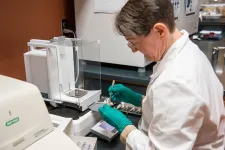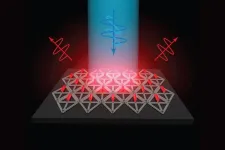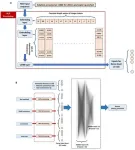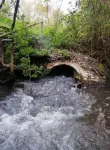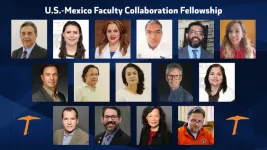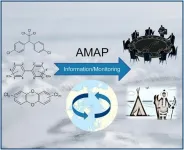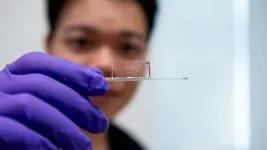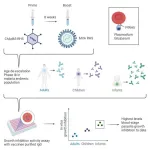(Press-News.org) Forensic researchers at the University of Tennessee Knoxville’s famous Anthropological Research Facility, popularly known as the “Body Farm,” have made headlines for decades in their discoveries of what happens to human bodies after death. Now, a multidisciplinary team—engineers, soil scientists, and biologists—digs in with them for a deeper look at what happens to the soil underneath a decomposing body. Their study, “Soil Elemental Changes During Human Decomposition,” published in June 2023 by PLOS One, could benefit investigators searching for human remains in remote or hard-to access-vegetated areas.
“This study was part of a larger project where we were investing environmental changes in the vicinity of a decomposing body,” said Jennifer DeBruyn, co-author and professor in the Herbert College of Agriculture Department of Biosystems Engineering and Soil Science (BESS). “Our bodies are concentrated in nutrients and other elements compared to the surrounding environment. As they break down, these nutrients are released into the environment, resulting in changes to soil and vegetation nearby.”
A greater understanding of how and when soil and vegetation changes in the presence of decomposing human remains may offer clues to both locating bodies and estimating how long they have been there.
To test their ideas, this study asks: What elements are released from the human body during decomposition and how does it influence the local soil environment?
“We have previously looked at the major elements of the body, namely carbon and nitrogen,” said DeBruyn, “But we know there are lots more in our bodies.”
The next most abundant elements in the body are sulfur, phosphorus, sodium, and potassium. As the soft tissues in test bodies decomposed, the team observed an expected pulse of these elements in the soils as they were released into the environment.
“What we were surprised to see was that we also had higher concentrations of calcium and magnesium than what we would expect from the input of the body alone,” said Stacy Taylor, lead author on the study and a postdoctoral researcher in DeBruyn’s lab. “While we do have calcium (Ca) and magnesium (Mg) in our bodies, much of it is tied up in our bones, which would take years or decades break down. Soils have capacity to bind cations like Ca2+ and Mg2+, so our hypothesis is that the changing conditions resulted in the release of these elements from the soil itself.”
They were also surprised to see an increase in some trace metals a few months into the soil testing, after soft tissues were largely decomposed.
“Again, the concentrations in soil were higher than what we would expect based on just what would be coming from the body,” said Taylor. “Decomposition fluids result in a gradual acidification of the soil over time, so our hypothesis is that as the pH was dropping, these trace metals were slowly being solubilized from mineral complexes in the soil.”
The big-picture take-away from their study could lead to new approaches in finding missing persons or in determining how long remains have been in a location.
“This study was an important documentation of the types of elements released during human decomposition and how they changed over time,” said DeBruyn. “It contributes to our broader understanding of local environmental changes during human decomposition, which may ultimately help us understand the timing of decomposition in cases where human remains are found outdoors.”
DeBruyn and her students and postdocs have been conducting research at the Anthropological Research Facility for over a decade, investigating the microbiological and environmental changes during human decomposition.
Their team for the study included DeBruyn, Taylor, and Michael Essington from BESS; Scott Lenaghan and Neal Stewart from the Center for Agricultural Synthetic Biology within the UT Institute of Agriculture; Amy Mundorff and Dawnie Steadman of the Forensic Anthropology Center, and Adrian Gonzalez, manager of the Water Quality Core Facility (WQCF) in the Department of Civil and Environmental Engineering.
The WQCF analyzed hundreds of soil samples that originated from underneath deceased human donors—those whose decision to volunteer their remains offers ongoing contribution to the furthering of this investigative science.
END
Interdisciplinary team studies decomposition effects on soil
2023-08-11
ELSE PRESS RELEASES FROM THIS DATE:
Arrays of quantum rods could enhance TVs or virtual reality devices
2023-08-11
Cambridge, MA – Flat screen TVs that incorporate quantum dots are now commercially available, but it has been more difficult to create arrays of their elongated cousins, quantum rods, for commercial devices. Quantum rods can control both the polarization and color of light, to generate 3D images for virtual reality devices.
Using scaffolds made of folded DNA, MIT engineers have come up with a new way to precisely assemble arrays of quantum rods. By depositing quantum rods onto a DNA scaffold in a highly controlled way, the researchers can regulate their orientation, which is a key factor in determining the polarization of light emitted by the array. This makes it easier ...
Artificial intelligence designs advanced materials
2023-08-11
In a world where annual economic losses from corrosion surpass 2.5 trillion US Dollars, the quest for corrosion-resistant alloys and protective coatings is unbroken. Artificial intelligence (AI) is playing an increasingly pivotal role in designing new alloys. Yet, the predictive power of AI models in foreseeing corrosion behaviour and suggesting optimal alloy formulas has remained elusive. Scientists of the Max-Planck-Institut für Eisenforschung (MPIE) have now developed a machine learning model that enhances the predictive accuracy by up to 15% compared to existing frameworks. This model uncovers new, but realistic corrosion-resistant alloy compositions. ...
Even treated wastewater affects our rivers
2023-08-11
Effluents from wastewater treatment plants have a dual effect: Some species disappear, while others benefit. Especially certain insect orders, such as stonefly and caddisfly larvae, are decimated. Certain worms and crustaceans, by contrast, can increase in number. A team from Goethe University Frankfurt led by Daniel Enns and Dr. Jonas Jourdan has corroborated this in a comprehensive study, which has now been published in the journal Water Research. They examined 170 wastewater treatment plants in Hesse in relation to species composition.
Wastewater treatment plants are ...
Study: Infant formula safety checks can be improved with stratified sampling
2023-08-11
URBANA, Ill. – Producers of infant formula employ comprehensive food safety systems, including product testing to ensure those systems are working. A new study from the University of Illinois Urbana-Champaign finds that some testing methods are more powerful at catching contaminants than others.
Spacing out samples over time in a stratified sampling pattern is better at catching risky pathogens like Cronobacter than randomly sampling from the product as it is being produced, the researchers found. Furthermore, while taking more samples of product generally increases the chance to catch the pathogen, there is a point after which it ...
UTEP launches new research partnerships with Chihuahua universities
2023-08-11
EL PASO, Texas (Aug. 11, 2023) – How are our region’s pecan farms affected by drought? Is there a better way to address domestic violence in Ciudad Juárez? These are a few of the big questions scientists are asking as they prepare to embark on a new cross-border research collaboration.
Created by The University of Texas at El Paso, the U.S.-Mexico Faculty Collaboration Fellowship program will support research projects with higher education institutions in the State of Chihuahua to spur studies on issues ...
Behind the rind: new genomic insights into watermelon evolution, quality, and resilience
2023-08-11
Watermelon is a globally significant agricultural product, both in terms of the total amount produced and the total economic value generated.
Scientists at the Boyce Thompson Institute have constructed a comprehensive "super-pangenome" for watermelon and its wild relatives, uncovering beneficial genes lost during domestication that could improve disease resistance and fruit quality of this vital fruit crop.
"We aimed to delve deeper into the genetic variations that make watermelons so diverse and unique," stated ...
Arctic monitoring program plays vital role in global pollution reduction efforts
2023-08-11
Historically, the Arctic was considered a pristine region, but scientific research spanning the last three decades has revealed the harsh reality of long-range transported pollutants reaching the Arctic from different corners of the world. In response to this alarming discovery, AMAP was created with the mission to monitor pollution and its effects on the Arctic environment and human health.
In a new article published on 26 July 2023, in the journal Environmental Science and Ecotechnology, researchers from Arctic Knowledge Ltd, presents the initiation and implementation of a systematic scientific and political cooperation in the Arctic related to environmental ...
University of Chicago scientists invent smallest known way to guide light
2023-08-11
Directing light from place to the place is the backbone of our modern world. Beneath the oceans and across continents, fiber optic cables carry light that encodes everything from YouTube videos to banking transmissions—all inside strands about the size of a hair.
University of Chicago Prof. Jiwoong Park, however, wondered what would happen if you made even thinner and flatter strands—in effect, so thin that they’re actually 2D instead of 3D. What would happen to the light?
Through a series of innovative experiments, he and his team found ...
Malaria vaccine candidate appears safe and produces promising immune response in a cohort of Tanzanian infants
2023-08-11
An experimental malaria vaccine appears safe and promotes an immune response in African infants, one of the groups most vulnerable to severe malaria disease. There is currently only one malaria vaccine, “RTS,S” that is approved by the World Health Organization and offers partial disease protection. However, in the results of the early-stage phase Ib trial conducted in Tanzania and published on August 11th in the journal Med, researchers find that targeting RH5 – a protein that the malaria pathogen Plasmodium falciparum uses to invade red blood cells – can generate a promising immune response ...
A roadmap to help AI technologies speak African languages
2023-08-11
From text-generating ChatGPT to voice-activated Siri, artificial intelligence-powered tools are designed to aid our everyday life — as long as you speak a language they support. These technologies are out of reach for billions of people who don’t use English, French, Spanish or other mainstream languages, but researchers in Africa are looking to change that. In a study published August 11 in the journal Patterns, scientists draw a roadmap to develop better AI-driven tools for African languages.
“It doesn’t ...
